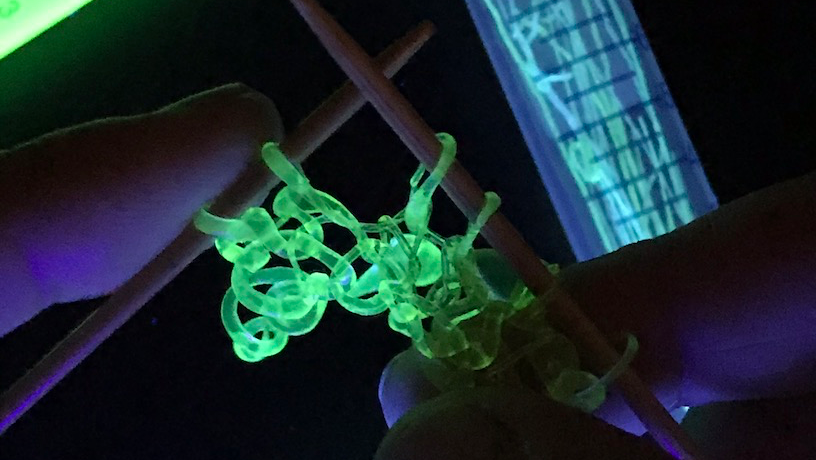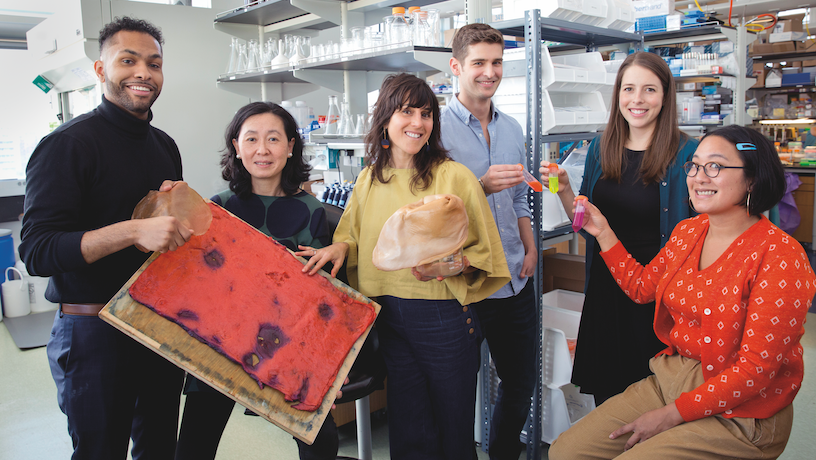Making Sustainability Fashionable

Detail of biotextile fibers.
This past spring, Theanne Schiros, a materials expert at Columbia Engineering, found herself on the beach in the Republic of Guinea in West Africa. But instead of a book, she held a rake in her hands. And instead of vacationing, she was with a crew of locals doing cleanup. “It was a landfill of textiles and plastic, five feet deep,” she says. “It brought home the fact that there is just no way you can make this stuff disappear.”
In truth, the fashion industry is among the most polluting in the world. “The anxiety over this can become paralyzing,” says Schiros. “Or it can inspire a big opportunity for change.”
She seized just such an opportunity in the summer of 2018, through the Columbia Center for Precision Assembly of Superstratic and Superatomic Solids (PAS3), a National Science Foundation-funded initiative where she’s been a principal investigator since 2015.
At the time, Schiros, also an assistant professor of science and sustainability at the Fashion Institute of Technology (FIT), was developing a kelp-based bioyarn with FIT alumni but faced challenges in making a material that could be used for practical garments. Jim Hone, a mechanical engineering professor and director of PAS3, introduced Schiros to Helen H. Lu, Percy K. and Vida L.W. Hudson Professor of Biomedical Engineering (BME), who has deep expertise in using bio-polymers for medical applications using a technique known as electrospinning.
“I’d never thought about a material I’d been using to make cartilage as something you could use to make a vest,” says Lu. “It really blew my mind.”
Together, Schiros’ and Lu’s teams, which include BME PhD candidate Romare Antrobus, produced a yarn made from their engineered materials, successfully spinning the project into a company called AlgiKnit.
The two collaborated again to create a bio-leather made from a bacterial nanocellulose, using a non-toxic enzyme treatment inspired by traditional tanning practices. (Their bag for Telfar Global debuts around the United Nations General Assembly and Fashion Week this fall through Slow Factory’s One X One conscious fashion initiative.) “Nature’s genius provides blueprints perfected over billions of years, and indigenous knowledge developed through collaboration with nature for thousands of years,” says Schiros. “We kind of lost that.” The bio-leather, and now a third project, Werewool, are ways to “use the tools of modern science and technology to reclaim that knowledge.”

Lab members Antrobus, Lu, Schiros, Brudnicki, Obermeyer, and Lee with unprocessed samples of various biotextiles.
Werewool (funded by PAS3) is arguably their most exciting venture yet: biodegradable performance textile fibers made with cellular proteins. Not only will production processes they developed dramatically reduce the environmental and social impact of conventional textiles, the materials themselves are compostable at the end of their life.
The idea behind it came from Schiros and former FIT students, Chui-Lian Lee, Valentina Gomez, and Morgana Kattermann. To create fibers that do not rely on agriculture, livestock, or petrochemicals, they focused on proteins, “but we’re not science people,” says Lee.
Schiros connected the three women with Allie Obermeyer, assistant professor of chemical engineering. An expert in colored proteins thanks to her protein engineering research, Obermeyer typically looks at biomaterials under a microscope, rather than on a scale tangible to the human hand. “Our normal challenge is to think about making these materials on a very small scale for niche applications. Suddenly we were figuring out how to manufacture on a marketing scale,” she says. “It’s exciting because it takes us out of the normal box we’re in. I think the best science comes from surprising places.”
The diverse team, which includes BME doctoral student Philip Brudnicki, has engineered prototypes of functional textiles fibers with inherent color and fluorescence, neatly avoiding the toxic fallout from most synthetic dyes.
Such synergy between chemical engineering, biomedical engineering, and textile design is the key to the success of bio-manufacturing and future of the biomaterial market (projected to reach $2.5 billion by the end of 2030).
“Together we can think about the end at the beginning of the process, so we are designing for a circular economy and a more sustainable world,” says Lu.
